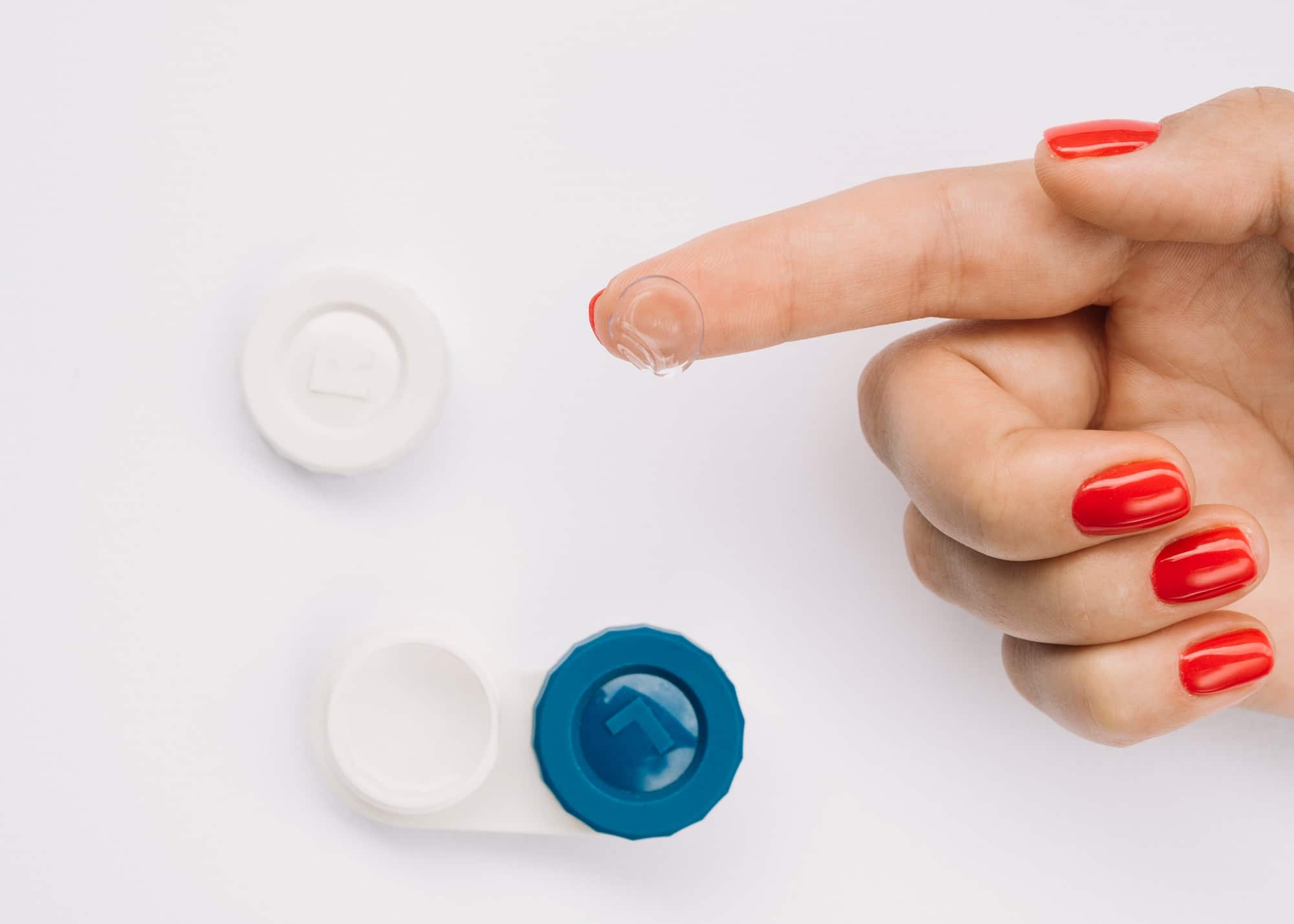
Scleral lenses are increasingly being utilized for patients suffering from irregular corneal conditions, such as keratoconus and ocular surface disease, such as severe dry eye. Research has shown that the most common reason for scleral lens failure is voluntary discontinuation due to difficulty with lens application and removal. Proper application and removal training at the dispense of your scleral lens will set the foundation for success with your scleral lenses.
All scleral lens experts will have a team member that is qualified to teach you the proper techniques for application and removal, as well as lens care. Here at CLEI our scleral lens application and removal training sessions have a 2 hour time allotment to allow a patient to learn in a calm, unrushed environment. Our technicians are simply the best. They are patient, caring, encouraging and most importantly exceptionally well trained to aid you in becoming a successful scleral lens wearer. Should you need additional training or want a refresher, we are always happy to provide one.
The most important thing to remember with scleral lenses is that application and removal is a learnt skill. It requires practice and patience. For those having difficulty, this article will answer some common questions. Before you visit Reddit r/scleral lenses or Facebook scleral lens support groups, ask your doctor.
Professional Guidance and Semantics
We know it’s just semantics but scleral lens application and scleral lens insertion are not the same. We want you to learn how to apply a scleral lens on the surface of your eye, we don’t want you to insert your lens anywhere but its storage case! That said, it cannot be over emphasized that successful application and removal must be taught to you at an application and removal training session by a qualified professional. Trying to learn scleral lens application and removal techniques at home on your own without the foundation of in-office training can lead to injury. If you are experiencing challenges it is important to communicate with your doctor to pursue further training. If you were not trained, or the prescriber of your scleral lenses does not offer further training if you need it, you should consider being cared for by another eye care professional. Online resources should only serve as reminders of what you learned at your training session.
Learning How to Adapt and Overcome Scleral Lens Application and Removal Obstacles
Each individual is unique, and learning to apply and remove as scleral lens requires finding the technique that works for them. Skill lenses and experience with contact lenses vary greatly from person to person. Some patients will pick up application and removal quickly, mastering it within a week or two, others may take a month or two. Either way don’t get frustrated or discouraged. Ensure you have ample time to practice at home. Do not allow yourself to be in a time sensitive situation where stress and anxiety can increase because you have to get somewhere.
Also other factors can influence the learning curve. Things like hand tremors, low vision, strong blink reflex, anxiety, and tight eyelids can make the process more challenging but with the right tools and training you can be successful.
Preparing For Scleral Lens Application
You will need several items for successful application and removal, and these tips are universal to all contact lens wearers. Hygiene is the most important part of application and removal. Wash your hands before touching your eyes or your lenses. Prior to handling scleral lenses, thorough handwashing with non-moisturizing soap is essential to prevent the transfer of oils that can compromise lens clarity and comfort. Hands should be dried completely with a lint-free towel to avoid towel fibers on or in your lenses.
Additionally a magnification mirror can be very helpful to aid in applying and removing the lens as well as ensuring there are no bubbles trapped behind the lenses. Alcohol prep pads can be used to clear the application and removal devices, these tools are often called lens plungers but they shouldn’t be plunging anything. These devices should be disposed of on a quarterly basis.
Environment Considerations
The environment you choose will affect application and removal. First ensure the environment you are in is clean. Avoid wet, dusty or windy environments. If you are going to use a bathroom counter to apply your lenses make sure you have the sink drain blocked so if you drop the lens you don’t lose it down the drain. Consider placing a towel over hard surfaces so if you drop the lens it doesn’t bounce. If you lose or break a lens contact your provider for guidance and a replacement lens. A general tip is if you are unable to function without lenses you should purchase a spare pair of lenses to ensure your life is not interrupted by lens loss or breakage. If you lose a lens down the drain and recover it, contact your provider for guidance prior to lens wear. If you decide to wear the lens without contacting your eye care provider, do not wear it without thoroughly cleaning the lens and inspecting it for damage and. If there is any discomfort, remove it immediately. Bright lighting is exceptionally helpful, in general the brighter the environment the easier it will be to see what you are doing.
Stand or Sit?
Each individual is different; some stand, some sit, some have health limitations and must do one or the other. Generally you should stick to what you were taught and successful with at your application and removal training. If you have no restrictions, do whichever is more comfortable to you. Once you master one technique you should try to learn the other for versatility.
Successful Lens Application
Putting a scleral lens on the eye is a learnt skill. When you are first learning it can be a frustrating experience. The most important thing is to be relaxed and not rush, accept that it is a learning process and let the improved vision or reduced pain be the motivation for success. Here are all the tricks and tips for successful lens applications.
Dry Hand, Dry Lids
Wet hands will cause your fingers to slide and prevent you from spreading and holding your eyelids apart. Additionally the oils from your eyelids or applied facial moisturizers can make lids slippery so for some, cleaning your eyelids will be an important step. In general the cleaner and dryer your fingers and eyelids are the better control you will have of your eyelids.
Overfill Your Scleral Lens
Avoid air bubbles by maintaining the lens’ saline fill until placement, ensuring correct lens positioning (centered and aligned if applicable), releasing the lens onto the eye at the appropriate time (if using a plunger), and verifying the absence of air bubbles. If you experience persistent difficulty achieving these steps, consult your eye care professional for further assistance.
Managing Air Bubbles
If bubbles persist, remove, refill, and reapply the lens, ensuring complete saline fill prior to placement. If you consistently encounter issues with air bubbles, inform your eye care provider.
Lens Removal
Following proper hand hygiene, tilt your head downward and look towards your nose. Gently retract the lower eyelid and, if necessary, utilize a plunger or your fingertip to release the lens suction. Carefully pinch the lens to remove it, repeating the process for the other eye. If you experience pain, excessive suction, or difficulty removing the lens, contact your eye care professional promptly.
Daily Lens Care
After removing the lenses, cleanse them with sterile saline solution and the prescribed lens cleaner. Thoroughly rinse with saline and disinfect according to your eye care provider’s instructions, which typically involves overnight soaking in a disinfecting solution. Store the lenses in a clean case filled with fresh disinfecting solution. If you notice any changes in lens appearance, such as discoloration or cloudiness, consult your eye care professional before using them.
Additional Considerations
Always adhere to your eye care provider’s specific instructions for lens care. Remove lenses before sleeping, avoid using tap water, and maintain regular follow-up appointments. If you experience any discomfort, irritation, or visual changes while wearing your lenses, promptly contact your eye care professional. By adhering to these guidelines and maintaining open communication with your eye care provider, you can ensure a successful and comfortable scleral lens wearing experience.





